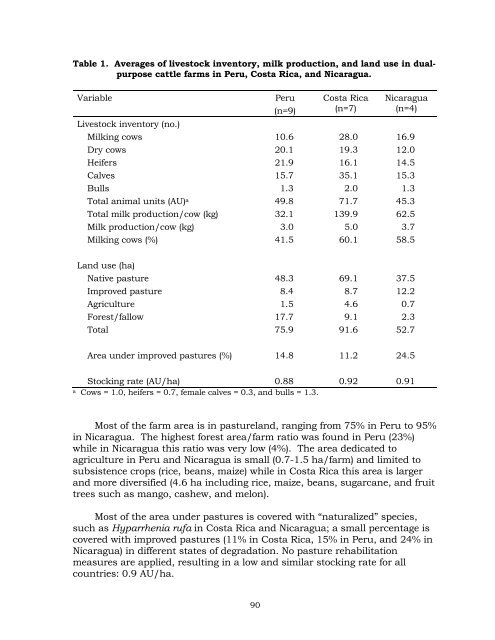Feeding Systems with Legumes to Intensify Dairy Farms - cgiar
Feeding Systems with Legumes to Intensify Dairy Farms - cgiar
Feeding Systems with Legumes to Intensify Dairy Farms - cgiar
Create successful ePaper yourself
Turn your PDF publications into a flip-book with our unique Google optimized e-Paper software.
Table 1. Averages of lives<strong>to</strong>ck inven<strong>to</strong>ry, milk production, and land use in dualpurpose<br />
cattle farms in Peru, Costa Rica, and Nicaragua.<br />
Variable Peru<br />
(n=9)<br />
Lives<strong>to</strong>ck inven<strong>to</strong>ry (no.)<br />
90<br />
Costa Rica<br />
(n=7)<br />
Nicaragua<br />
(n=4)<br />
Milking cows 10.6 28.0 16.9<br />
Dry cows 20.1 19.3 12.0<br />
Heifers 21.9 16.1 14.5<br />
Calves 15.7 35.1 15.3<br />
Bulls 1.3 2.0 1.3<br />
Total animal units (AU) a 49.8 71.7 45.3<br />
Total milk production/cow (kg) 32.1 139.9 62.5<br />
Milk production/cow (kg) 3.0 5.0 3.7<br />
Milking cows (%) 41.5 60.1 58.5<br />
Land use (ha)<br />
Native pasture 48.3 69.1 37.5<br />
Improved pasture 8.4 8.7 12.2<br />
Agriculture 1.5 4.6 0.7<br />
Forest/fallow 17.7 9.1 2.3<br />
Total 75.9 91.6 52.7<br />
Area under improved pastures (%) 14.8 11.2 24.5<br />
S<strong>to</strong>cking rate (AU/ha) 0.88 0.92 0.91<br />
a Cows = 1.0, heifers = 0.7, female calves = 0.3, and bulls = 1.3.<br />
Most of the farm area is in pastureland, ranging from 75% in Peru <strong>to</strong> 95%<br />
in Nicaragua. The highest forest area/farm ratio was found in Peru (23%)<br />
while in Nicaragua this ratio was very low (4%). The area dedicated <strong>to</strong><br />
agriculture in Peru and Nicaragua is small (0.7-1.5 ha/farm) and limited <strong>to</strong><br />
subsistence crops (rice, beans, maize) while in Costa Rica this area is larger<br />
and more diversified (4.6 ha including rice, maize, beans, sugarcane, and fruit<br />
trees such as mango, cashew, and melon).<br />
Most of the area under pastures is covered <strong>with</strong> “naturalized” species,<br />
such as Hyparrhenia rufa in Costa Rica and Nicaragua; a small percentage is<br />
covered <strong>with</strong> improved pastures (11% in Costa Rica, 15% in Peru, and 24% in<br />
Nicaragua) in different states of degradation. No pasture rehabilitation<br />
measures are applied, resulting in a low and similar s<strong>to</strong>cking rate for all<br />
countries: 0.9 AU/ha.
















